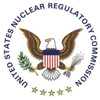Catalog of Environmental Programs 2012
| Federal agencies that contribute to EPA's environmental goals, and how they make a difference. |
the Catalog |
All Programs |
Programs by EPA Strategic Goal 1. Climate Change and Improving Air Quality 2. Protecting America's Waters 3. Cleaning Up and Sustainable Development 4. Safety of Chemicals and Preventing Pollution |
Programs by Agency AID, ARC, CNCS, CPSC, CSB, DHS, DOC, DOD, DOE, DOI, DOJ, DOL, DOS, DOT, ED, FHFA, GSA, HHS, HUD, NASA, NRC, NSF, OSTP, SBA, TVA, USDA, USPS, USTR, VA |

Nuclear Regulatory Commission |

EPA Goal 3: Cleaning Up Communities and Advancing Sustainable Development |
Nuclear Materials – Uranium Recovery
Purpose
As the precursor to the nuclear fuel cycle, uranium recovery focuses on extracting
(or mining) natural uranium ore from the Earth and concentrating (or milling) that
ore. For mining activities, the regulatory responsibility depends on the extraction
method that the given facility uses. The U.S. Nuclear Regulatory Commission (NRC)
regulates in situ recovery (formerly known as in situ leach recovery), where the
uranium ore is chemically altered underground before being pumped to the surface
for further processing. Thus, the NRC becomes involved in uranium recovery operations
when the ore is processed and chemically altered. This happens either in a
uranium mill (the next step in processing ore from a conventional mine) or
during in situ recovery (ISR). For that reason, the NRC regulates in situ
recovery facilities (as stated above), as well as uranium mills and the disposal
of liquid and solid wastes from uranium recovery operations (including mill tailings).
Currently, the NRC regulates active uranium recovery operations in Wyoming,
New Mexico, and Nebraska. However, the NRC does not directly regulate the active uranium
recovery operations in Texas, Colorado, and Utah, as they are Agreement States, meaning
that they have entered into strict agreements with the NRC to exercise regulatory authority
over this type of material.
Uranium milling and disposal of the resulting waste byproduct material by NRC
licensees are regulated under Title 10, Part 20, of the Code of Federal Regulations
(10 CFR Part 20), "Standards for Protection Against Radiation"; 10 CFR Part 40,
"Domestic Licensing of Source Material"; and Appendix A to 10 CFR Part 40. As
its title implies, Appendix A sets forth the criteria relating to the
operation of uranium mills and the disposition of tailings or wastes
produced by the extraction or concentration of source material from
ores processed primarily for their source material content. In general,
these criteria require uranium recovery facilities to control industrial
hazards and address waste and decommissioning concerns.
Source(s) of Information
1. NRC: Uranium Recovery
Related EPA Program(s)
RCRA: Waste Management:
EPA will prevent dangerous releases to the environment from RCRA hazardous waste generators, transporters, and treatment, storage, and
disposal (TSD) facilities. EPA will reduce materials and energy use through product and process redesign and increase materials and
energy recovery from wastes otherwise requiring disposal.
Authorizing Legislation
• Solid Waste Disposal Act (SWDA), Sections 8001 and 3011 (a) and (c) as amended
• Resource Conservation and Recovery Act (RCRA) of 1976, as amended, Public Law 94-580, 42 U.S.C. 6901 et seq.
• Department of Veterans Affairs and Housing and Urban Development and Independent Agencies Appropriations Act, Public Law 105-276 112 Stat.2461, 2499 (1998)
Other Programs under Goal 3
Other Programs from NRC
Top of page


